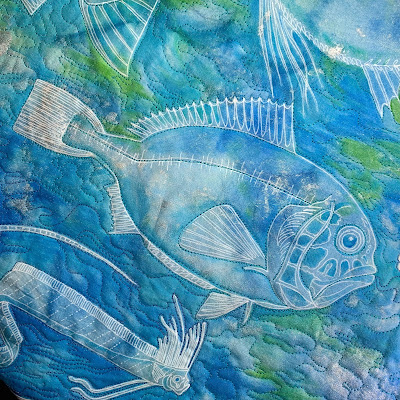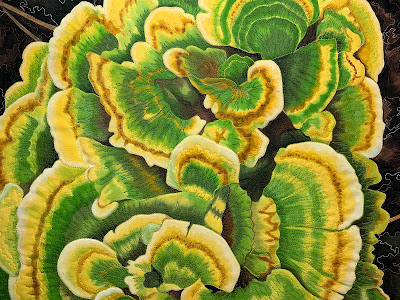Sunday, March 13, 2022
Let's raise funds for World Central Kitchen!
Tuesday, March 8, 2022
Blue Water Film Festival
“Net of Wonder” is a piece I made for the exhibition “A Better World: Heroes Working for the Greater Good,” and celebrates the work of Jacques-Yves Cousteau (1910-1997), an explorer and environmentalist passionate about the sea and everything that swam or crawled in it. He helped develop the first scuba equipment, which enabled researchers to more closely study underwater environs. Cousteau warned us about the dangers of coastal development, pollution, exploitation, and over-fishing. His life was one of extraordinary passion and purpose. “The sea,” Cousteau said, “once it casts its spell, holds one in its net of wonder forever.”
As a child, I loved watching “The Undersea World of Jacques Cousteau,” a TV show that aired in the U.S. from 1966 to 1976. In the Calypso, a former French naval vessel, and in his little yellow submarine, Cousteau took me to places I will never be able to visit. He opened my eyes to the diversity and splendor of the ocean, and the need to protect it.
Tuesday, March 1, 2022
“Native Beauties in Fabric and Thread”
In lieu of a reception, I’ll meet with visitors and demonstrate techniques I used to create these 15 pieces on April 2. Please come; I’d love to meet you!
Wednesday, January 26, 2022
Oaks
Wednesday, January 19, 2022
Turkey Tail Fungus
 |
“Turkey Tail Fungus” Copyright Susan Brubaker Knapp 2022 20.75 x 25.5" |
White cotton fabric, acrylic textile paint, cotton batting, interfacing, cotton backing, cotton thread. Wholecloth painted, free-motion quilted.
Friday, December 17, 2021
“Pink Coleus” on Mancuso site
Here’s the whole piece:
Studio Tour Video
Our wonderful realtor, Natalie Marrone, who helped us find our home here in Chapel Hill, made a video for her business that features me! The idea was to tell folks interested in moving to the area about our active arts scene.
Saturday, November 27, 2021
Witch Hazel
 |
| “Witch Hazel” Copyright Susan Brubaker Knapp 2021. About 26x21”. Wholecloth painted, free-motion machine quilted. |
Hamamelis virginiana (Witch Hazel) is a species of flowering shrub native to eastern North America, from Nova Scotia west to Minnesota, and south to central Florida to eastern Texas.
The information below is from Larry Stritch of the U.S. Forest Service:
American witchhazel posses some interesting lore and uses. The most interesting use as been the use of forked limbs as dowsing or divining rods. Early European settles observed Native Americans using American witchhazel to find underground sources of water. This activity is probably where the common name witchhazel came from. “Wicke” is the Middle English for “lively’ and “wych” is from the Anglo-Saxon word for “bend.” American witchhazel was probably called a Wicke Hazel by early white settlers because the dowsing end of the forked branch would bend when underground water was detected by the dowser. This practice had a widespread use by American settlers and then exported back to Europe. Dowsing became an established feature of well-digging into the 20th century.
From Wikipedia:
Native Americans produced witch hazel extract by boiling the stems of the shrub and producing a decoction, which was used to treat swellings, inflammations, and tumors.[6] Early Puritan settlers in New England adopted this remedy from the natives, and its use became widely established in the United States.[7]
An extract of the plant is used in the astringent witch hazel.
H. virginiana produces a specific kind of tannins called hamamelitannins. One of those substances displays a specific cytotoxic activity against colon cancer cells.[8]
The bark and leaves were used by Native Americans in the treatment of external inflammations. Pond's Extract was a popular distillation of the bark in dilute alcohol.
Wednesday, November 24, 2021
Updated website
I’m updating my website, and transitioning to a new name – www.SusanBrubakerKnapp.com. I’ll still keep the BlueMoonRiver.com URL, but if you try to reach it in the future, it will automatically take you to SusanBrubakerKnapp.com.
This is the third software I’ve used to design my website. I started with Adobe GoLive, and then Adobe eliminated it, so I switched to Adobe Muse. Guess what? Adobe decided to stop supporting and updating it, too, a few years ago. It continued to work pretty well since then. But last week, when I went to update my website, the slideshow function refused to work, so now I'm jumping over to Adobe Portfolio.
I like to create and update my own website, not so much because I’m a cheapskate and don’t want to pay someone, but because I’m a bit of a control freak. And I often update my website in the middle of the night in my pajamas.
New on the website are galleries of work on the “Fiber Art” page that will be grouped by the year pieces were created. I will have a separate page that lists work for sale.
I’ve also added a page with information and photos about Quilting Arts TV.
I’m still trying to figure out ways to make certain things work (like links to PDFs of projects and tutorials), but at least I have a semi-functional website up.
Take a look, and let me know what you think. Constructive criticism only, please!
Wednesday, November 10, 2021
Studio Tour!
Here’s how it works:
First, download the brochure here (at the Orange County Artists Guild website, ocagnc.org) and figure out which studios you want to visit. All the studios are numbered, and there's a handy map. I'm stop 68.
Next, grab a friend or two (and a mask, which is required inside all the studios this year), and start your drive. At each location, signs mark a spot. Parking and accessibility varies from location to location, because these are private homes, in most cases. At my house, parking will be on the street, and then there’s a short hike up a steep driveway to the studio entrance that faces the street.
A painting of Dr. Fauci (by wonderful local artist Katie Porterfield) greeted people at my door with a not-so-subtle reminder to put on your mask before coming inside. Orange County has the highest vaccination rate in the state of North Carolina, and correspondingly low rates of COVID, and we’d like to keep it that way.
Inside, I have displayed most of my smaller pieces, and some of my larger ones. I also have binders of my entire portfolio, and merchandise like magnets, prints, notecards, and books to purchase. I even have some of my hand-knitted dishcloths that I made during COVID lockdown!
Thursday, October 21, 2021
Venus Flytrap
Charles Darwin called it “the most wonderful plant in the world” in 1875.
The Venus flytrap is a fascinating carnivorous plant native to a 75-mile radius of Wilmington, NC. It is endemic in 14 coastal NC counties and one SC county with boggy, swampy coastal plains. It catches its prey, spiders and insects, by snapping shut the spiky parts of its leaves once the tiny hairs inside ("trigger hairs") are set off by the insect’s movement.
Unfortunately, this plant is highly poached and because of this – plus fire suppression and habitat loss – it has dramatically declined in its native range. It is under review to be added to the Endangered Species Act by the U.S. Fish & Wildlife Service. You should only buy it from reputable buyers who have cultivated, rather than poached it. And if you see it in stores, you should never “tease” the plant by triggering it to close up.
Here’s some interesting details from Wikipedia about how the plant got its name:
Etymology
The plant's common name (originally "Venus's flytrap") refers to Venus, the Roman goddess of love. The genus name, Dionaea ("daughter of Dione"), refers to the Greek goddess Aphrodite, while the species name, muscipula, is Latin for both "mousetrap" and "flytrap".[7][8] The Latin word muscipula ("mousetrap") is derived from mus("mouse") and decipula ("trap"), while the homonym word muscipula ("flytrap") is derived from musca ("fly") and decipula ("trap").[9][10][8]
Historically, the plant was also known by the slang term "tipitiwitchet" or "tippity twitchet", possibly an oblique reference to the plant's resemblance to human female genitalia.[7][11] The term is similar to the term tippet-de-witchet which derives from tippet and witchet (archaic term for vagina).[12][13] In contrast, the English botanist John Ellis, who gave the plant its scientific name in 1768, wrote that the plant name tippitywichit was an indigenous word from either Cherokee or Catawba.[8][14] The plant name according to the Handbook of American Indians derives from the Renape word titipiwitshik ("they (leaves) which wind around (or involve)").[15][16]
When I quilted this piece, I outlined everything in black thread for a graphic, cartoon-y look, and then I added echo quilting around the leaves to give it a sense that the plant was moving. I can’t figure out if the plants look scary and ominous, or if they are laughing. Maybe both?






























































